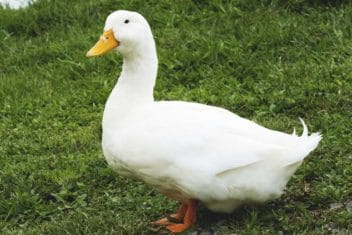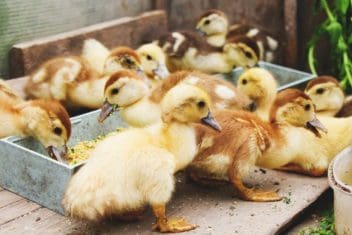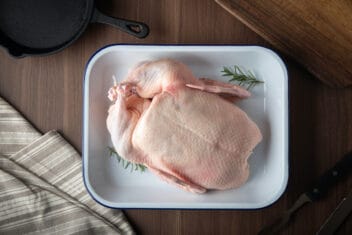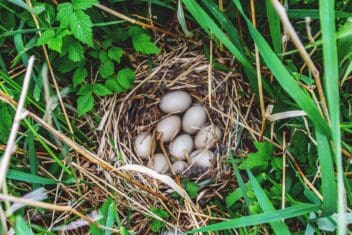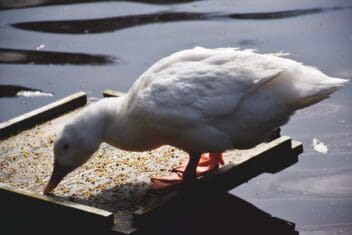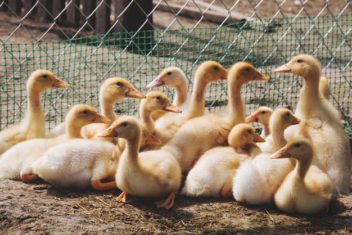It was a few years ago, in the middle of winter, when I decided I wanted to bring home my first set of ducks. And let me tell you, I knew nothing about ducks. A friend of mine went and picked up a pair of Pekins at the local auction for me.
Upon their arrival, I found out I had their coop all wrong!
But thankfully they are durable little critters because they had to go through my learning curve with me.
I don’t want any other owner (or ducks for that matter) to have to go through the same trial and error process that I did. Which is why today I want to start with their coop.
Before we begin, you might also want to read these articles:
- 12 Things You Need to Know Before Getting Your First Ducks
- All You Need to Know About Duck Eggs
- Feeding Ducks: What Do Ducks Eat, What NOT to Feed, and Everything Else
- 34 Chicken Coop Plans (chicken and duck coops are structurally similar, you can use it for inspiration)
Now, let’s get started.
1. Let The Coop Breathe
This was one thing I got right when building our duck coop. We knew from chickens that we needed plenty of ventilation.
Be sure that your coop has lots of room to breathe. Ducks put off moisture when they breathe. Therefore, their breath can actually cause mold in their bedding from it being so wet. It can actually cause frostbite on their legs during the colder winter months.
So make sure that there is ventilation towards the top of the coop and anywhere on the side you deem necessary as well.
2. Make It Easier to Keep Clean
There are a few things you can do to make it easier on you to keep it clean.
First, you can make the coop large enough for you to walk in. A walk-in coop actually makes it to where you can add shelving to store the ducks’ food and other items right inside the coop. But if not, you can make the coop have a roof that can be easily lifted up so you can get inside of it.
You can also make the floor to where it slides out. If nothing else, definitely paint the interior with exterior paint. All of these things will make it easy to simply pull out the water hose and spray it down.
3. Provide Larger Entrances And Exits
The ducks’ entrance and exit of their coop are super important. The reason is that although ducks are sweet little creatures, they can be pushy, and there is no orderly ‘have your ducks in a row’ when it comes to entering their coop.
So be sure to create their entrances and exits with that in mind. It should be big enough for at least two ducks to enter or exit at a time. If not, you may come out to find that your ducks are stuck in the door of their coop.
We were fortunate that we never faced this hardship. But I can’t imagine how difficult that would be to pull two ducks out of a stuck door way. It makes me hurt just thinking about it.
4. The Actual Structure
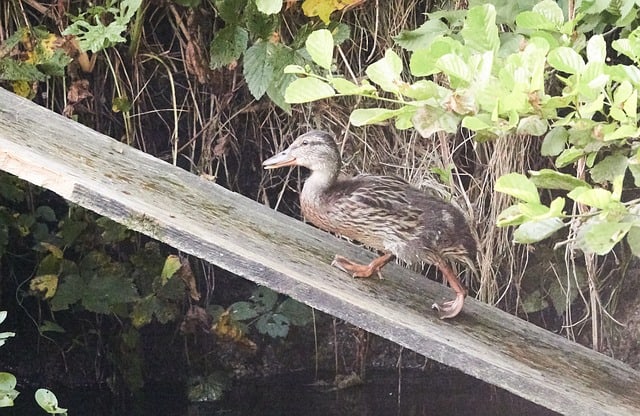
The actual structure of a duck coop can be as basic or as fancy as you’d like. Our first duck coop was built out of PVC pipe, chicken wire, leftover greenhouse plastic, and a really cool sliding door.
And our next (and current duck coop) was built out of pallets. I’m hoping one day they’ll get to graduate to an adorable duck house. Until then, I dream.
There are important things to note about the structure, though.
First, it should be around ground level. I messed this up big time with my first coop. I was so worried about predators I practically put it on stilts.
Second, if you can’t put it on the ground then you need a ramp for them to walk into it. However, don’t make it so high off the ground that the ducks have to climb a steep incline to get in their coop. We did this and our ducks wouldn’t use the coop because they wouldn’t climb that high up.
Third, keep in mind the coop needs to be big enough that you can have at least 4 square feet of floor space for each duck.
5. Water, Water, Water
Ducks love water.
But they don’t require an actual body of water. You can do something as simple as giving them a kiddie pool.
We actually dug a deep hole in the ground and lined it with a heavy-duty tarp. Then we filled it with water so they got a mini inground swimming pool.
They really loved it.
They also need lots of drinking water. This is super important, as they need to water to aid with eating their food.
The next challenge within your coop is going to prevent water spillage. Here’s a tip: keep their food at least two yards away from their drinking water because ducks are extremely messy and will muck up their food really quickly.
You might want to come up with a water disposal plan. I like this one so it is easy to reuse the water for fertilizing and watering plants. Ducks’ water becomes rather nasty really quickly. They will play in it, drink it, and poop in it.
If you are just starting out, you could also plan your whole homestead around using the water from the pond for fertilization, watering of plants, and even as a source of water should a fire break out. Read our interesting post on water hydrology for more on that.
6. A Comfy Bed

Ducks are really not finicky creatures. They are happy with food, some kind of water, and a coop that has plenty of air running through it. Honestly, the more run down the coop is the happier they appear to be in it.
But still, bedding is important.
You can use either shavings or straw. Shavings are okay as they are comfortable and help absorb some of the moisture. Straw works really well because it doesn’t get as wet as fast and it keeps its shape a little better.
It is important to mention that you never want to leave wet or soiled bedding in the coop. This too is a great place for mold and fungus to begin growing. As I already mentioned, this can really upset and infect the ducks’ respiratory systems.
So if you are looking to give your ducks the comfiest of places to sleep, consider these two bedding options.
7. Location, Location, Location
You really need to think about where you are going to locate your ducks’ coop for multiple reasons.
First, the closer it is for you to easily check and see what is going on the harder it is going to be on predators. Because one glance out of your window, and you can quickly spring into action if needed.
Second, you need to figure out which direction your strongest winds come from. That way you can build the coop in the direction with the most protection.
Finally, try to place your coop near your compost pile and where gravity will be your friend. You will get a lot of wet bedding and good fertilizer from your ducks’ coop. Imagine how much easier it will be on you if you could simply open the coop and spray it all downhill directly into your compost pile.
So just try and place your coop accordingly so it will equate to making life a little easier on you.
8. No Clutter
Ducks are not a friend to clutter or debris. Their feet can be easily harmed if they step on glass, a nail, or any other sharp debris. Not to mention, a duck will try to eat anything. So you don’t want them choking down the wrong thing.
Be sure to clean the area where they roam thoroughly.
For instance, my goats wear collars with bells. One day one of their bells went missing. When I was looking for it, I noticed my ducks were trying their best to chomp on something so I went to investigate.
Sure enough, they were trying to eat the missing bell.
Thankfully, it was much too big. But had that been something smaller like a piece of glass or a small screw I could have lost a duck.
So keep that in mind when cleaning out the area for their future home.
9. A Nesting What?
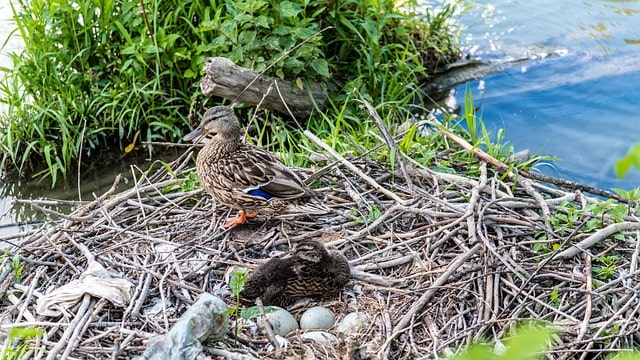
Ducks aren’t similar to chickens. There, I said it. They can co-exist wonderfully. But as far as thinking the two are alike, you’d be mistaken.
As you know, chickens love their nesting boxes. They fight over who gets the best one. And mine even sleep in them though they have plenty of roosting space.
But ducks don’t really care for nesting boxes.
They will rarely use them.
Some of them will prefer to make some beautiful nests out of any material they can find. They really are gorgeous!
So if you decide to give your ducks a nesting box, know that it needs to be on the ground and about 14 square inches. But if you’d rather them just do their own thing and create their own nests from straw and whatever else that is certainly okay too.
10. “I’ll huff, and I’ll puff, and I’ll blow your house in”
Unfortunately for your ducks, they and the three little pigs have the same problem. They both have predators.
A duck’s biggest predator is probably a raccoon. They are smart little creatures.
So you must predator proof their coop.
First, begin with giving your ducks a solid floor under their coop. It should be wood, cement, or even vinyl to stop critters from coming up from under the coop.
Second, your ducks need windows in their coop for ventilation. However, be sure to place hardware cloth over these windows.
And consider adding shutters so that they can be closed at night. That way predators can’t see in and scare your ducks. Nor does it entice them to try to get into the coop.
Finally, use multi-step latches. Raccoons have the same intelligence of a toddler. (Or so it has been said.) So if a toddler can open a latch the raccoon probably can too.
So be sure to use latches like the ones that have the hook that has to fit into the hole. It is difficult for them to figure that out. Or use multiple latches on your coop. Anything to make the process as difficult as possible on the predator.
Well, that’s it for me today guys. I hope this has helped you all to figure out what duck coop considerations are vital when building or buying a duck coop for your precious web-feet friends.
Be sure to continue to our next post – DIY plans for a Duck Coop, now that you know what the duck coop considerations are.



